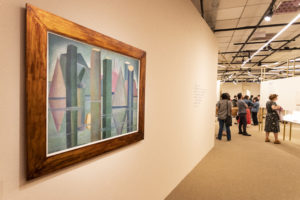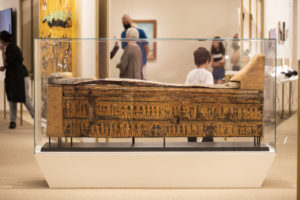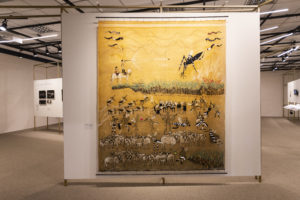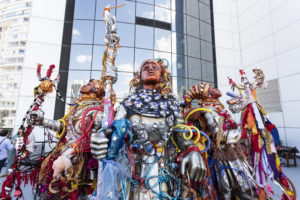São Paulo – What did Egypt bring to the Brazilian Modernism? Many things, the curators of the exhibition Desvairar 22 discovered. Showing at SESC Pinheiros in São Paulo, Brazil, until January 15, 2023, the exhibit brings over 270 items, including a sarcophagus from 3000 BC, pictures of the expedition of D. Pedro II to Egypt, and popular songs such as “Allah-La Ô”. You can also find among them works by modernists such as Tarsila do Amaral as well as new-generation artists.
The show celebrates 100 years of the Week of Modern Art that took place in 1922 at Theatro Municipal de São Paulo and changed Brazilian culture, and the Bicentennial of the Independence of Brazil. It has free admission and showcases visual arts, music, literature and architecture divided into four sections.

Since 2019, Marta Mestre, Veronica Stigger and Eduardo Sterzi have worked in curating the exhibition. “It was Mestre’s idea. It all came from the fact that Dom Pedro II traveled to Egypt, when he brought a lot of things, including mummies and treasures. He was a savvy character, and it’s interesting to notice how this trip already began to create an image of what Egypt was. An image from another place, another possible life and experience,” she said.

But another expedition also marks the development of the show. “Another thing that Mestre brough was the trip that some Modernist artists like Tarsila do Amaral and Oswald de Andrade took to Egypt. And Tarsila do Amaral made an album containing a series of clippings and drawings she did. And some of them served as an inspiration for the painting that opens the exhibition, Calmness II. There we can see already an idea of ‘Egypt’ caught in the geometrization of shapes,” Stigger told ANBA.
From a sarcophagus to É o Tchan
The curator believes that the image of Egypt goes beyond the paintings, being present in literature and music. “In Edgar Morin’s book Man and Death [by Menotti del Picchia], one of the characters is an architect that wants to build a sphinx,” she said. Another example is a charge by Brazilian cartoon artist Laerte where a sphinx asks, “Decipher me some other time.”

But another expedition also marks the development of the show. “Another thing that Mestre brough was the trip that some Modernist artists like Tarsila do Amaral and Oswald de Andrade took to Egypt. And Tarsila do Amaral made an album containing a series of clippings and drawings she did. And some of them served as an inspiration for the painting that opens the exhibition, Calmness II. There we can see already an idea of ‘Egypt’ caught in the geometrization of shapes,” Stigger told ANBA.
From a sarcophagus to É o Tchan
The curator believes that the image of Egypt goes beyond the paintings, being present in literature and music. “In Edgar Morin’s book Man and Death, one of the characters is an architect that wants to build a sphinx,” she said. Another example is a charge by Brazilian cartoon artist Laerte where a sphinx asks, “Decipher me some other time.”

Other works are scattered across the section Longing for Egypt, which brings together pictures of the expedition that Dom Pedro II did to Egypt in the 1870, newspapers of the time reporting the discovery of the Tomb of Tutankhamun, and photos by Marcel Gautherot of the pharaonic architecture of Brasília. There are also Egyptian inspirations in artworks like the opera Aida, songs by Margareth Menezes and Jorge Ben Jor, and a music video by É o Tchan. Furthermore, the black roots of the African country are highlighted in works by Abdias do Nascimento.

The section “Bones of the World,” there are also figures that refer to the mummies in works like Cristiano Leenhardt’s. And even the mosquito Aedes aegypti, native from Egypt, is depicted in works like Oswald de Andrade Filho’s. The section “Means of Transportation” includes records like the visit of airship Graf Zeppelin to Brazil in the 1930s and a stuck trolley photographed by Mário de Andrade. Finally, “Índios Errantes” showcases works by artists such as Anna Maria Maiolino, Carybé, Lygia Pape, Paulo Nazareth, and Regina Parra.
In addition to the collective work, the trio of curators also invited Gabriel Haddad and Leonardo Bora of Carnaval school Acadêmicos do Grande Rio to collaborate in the show. “We had the idea of adding an allegorical car, so we invited Haddad and Bora, who won Carnaval [in Rio de Janeiro] this year. Since the allegorical car is huge, they proposed to take the top of the last car, which has exunauts, a mix of Esú and astronauts. And those who go to the balcony see that they are looking up, into the great beyond,” she said.
The installation Exunauts is at the balcony of the space and ends the show, which is part of the network “Diverse 22: Projects, Memories, Connections” developed by SESC São Paulo.
Quick facts
Exhibition “Desvairar 22”
Visitation until January 15, 2023
Tuesday to Saturday, 10:30 am to 9 pm | Sundays and holidays, 10:30 am to 6 pm
SESC Pinheiros – Address: Rua Paes Leme, 195, Pinheiros, São Paulo, SP
Free admission
Translated by Guilherme Miranda




